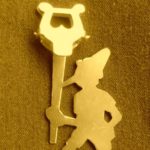Kawai 25-A
Tagged: Kawai 25-A, Suzuki Melodion A-25C
- This topic has 7 replies, 4 voices, and was last updated 8 years, 2 months ago by
 Alan Brinton.
Alan Brinton.
-
AuthorPosts
-
August 13, 2015 at 1:34 pm #5802
 Alan BrintonParticipantAugust 13, 2015 at 6:45 pm #5803
Alan BrintonParticipantAugust 13, 2015 at 6:45 pm #5803 Alan BrintonParticipant
Alan BrintonParticipantI’m thinking it is probably a Kawai-branded 1980s Suzuki A-25C. I’ve been trying to find one of those for about two years, with no success.
August 28, 2015 at 12:14 am #5857 Alan BrintonParticipant
Alan BrintonParticipantThis arrived today. It is indeed the Suzuki Melodion A-25C (1987-91). This one is in mint condition. The A-25C is the final chapter in the development of Suzuki’s A-25 series, which began in 1968. I have all members of the series, with the exception of the A-25B. They are all very good, but this is the best. It’s the A-25 I have been looking for, and it fully satisfies my expectations. I’m not sure what words best capture its distinctivenes, “most musical” perhaps.
August 28, 2015 at 1:27 am #5858 AndreParticipant
AndreParticipantHi Alan
This one looks so cool 🙂 Great acquisition!January 29, 2016 at 2:03 am #6768 Alan BrintonParticipant
Alan BrintonParticipantI am now ready to post more detail on the Suzuki Melodion A-25C, which was the culmination of the development of Suzuki’s high end small (25-27 key) melodions. I have seen only one A-25C for sale, recently, on which I did not bid because it appeared to be in questionable condition, while I have two of the Kawai version, the Kawai 25-A, one in very good condition and the other virtually brand new. This Melodion is essentially the 25 key version of two of Suzuki’s best current models, the M-32C and the M-37C. Its only serious competitor among currently available Japanese keyboard harmonicas is the excellent Yamaha P-25F, to which it is, in my opinion, superior. I have now taken apart both my Kawai 25 A Melodions and have cleaned and tuned them. This is an easy model to take apart and tune. Four small screws release the end pieces, after which the instrument can be either rotated or slid out of its metal tray. Then four large screws secure the reed chamber cover. These can be easily and repeatedly removed and replaced during the tuning process without concern about stripping screw holes or heads. A No.1 precision screwdriver suffices for all screws. Here now are photos. You won’t see any difference between the two Melodions except for the discoloration of the reeds/reed plate on one, about which I’ll comment.

This is the one that’s in mint condition.


Once the end pieces are removed, the inner melodica slides out smoothly or can be easily rotated out. Construction and fit of the parts is excellent.





Okay, so here we see the only noticeable difference between these two Melodions, discoloration of the reeds on the one that has been used.

And so it gets a two hour soaking in a 1 to 3 vinegar-water solution:

And an easy going toothbrush work-over with moistened baking soda. Here are the reeds after cleaning:

as compared with the reeds of the mint condition specimen:



You can see that this Melodion has been tuned — at the factory I’m assuming, since there are no signs of its having been played.

A few gapping adjustments were required, as is illustrated here by an overhead view of gaps. C-5 is the reed with the gap that needed opening the reed to the left of the screw head on the right.

My main instrument for tuning reeds is now a variable speed electric engraver, with a few finishing touches done by hand.
January 29, 2016 at 4:56 am #6770 Melodica-MeParticipant
Melodica-MeParticipantWow, these look great Alan.
Great work
Melodica-MeFebruary 1, 2016 at 12:30 pm #6781 Bruno TraviParticipant
Bruno TraviParticipantGood job Alan ! With your experience, as is better to clean a Clavietta?
February 1, 2016 at 2:18 pm #6782 Alan BrintonParticipant
Alan BrintonParticipantThe Clavietta is much much more complicated, and I wouldn’t soak it in water.
-
AuthorPosts
- You must be logged in to reply to this topic.


